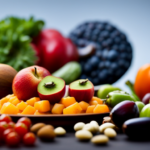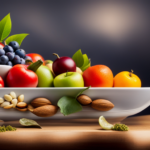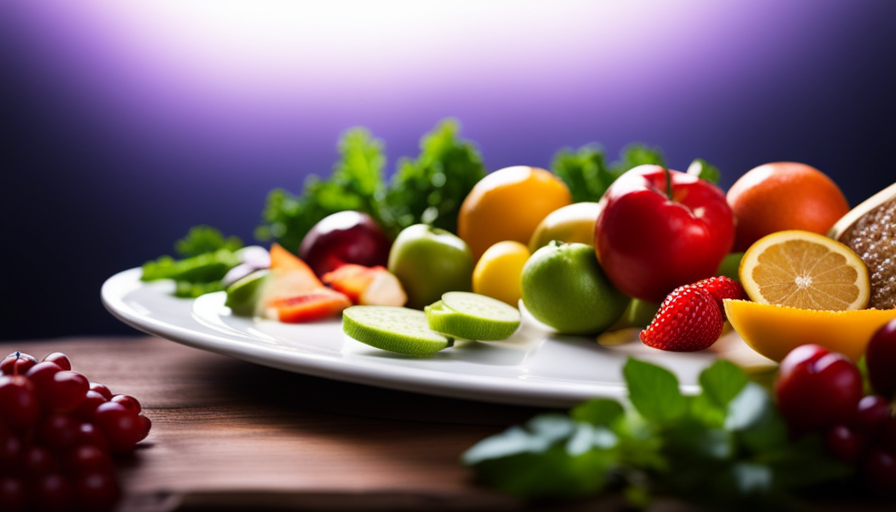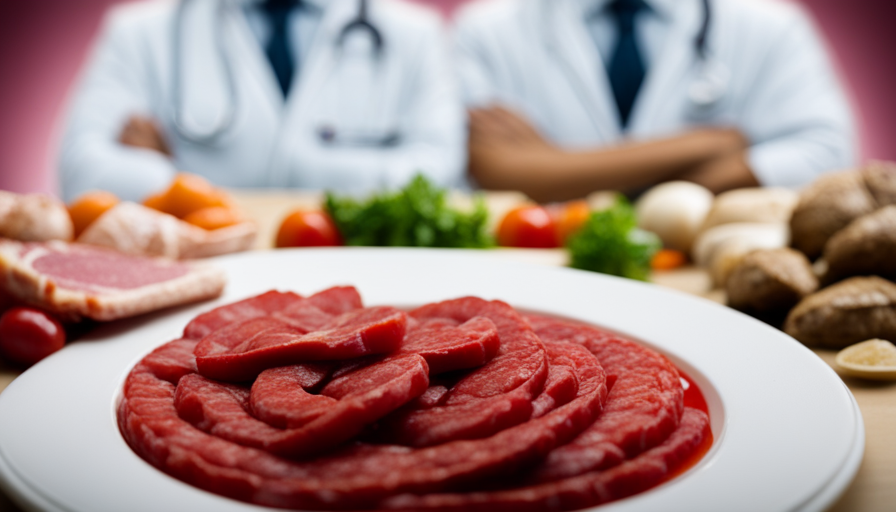Have you ever thought about the idea of a raw food diet and the real thoughts that people have about it?
Well, let me take you on a journey into the world of raw food diets and explore what people consider about this unique way of eating.
From health benefits to concerns and criticisms, personal experiences to expert opinions, and practical tips to addressing misconceptions, this article aims to provide you with a comprehensive understanding of raw food diets.
But before we delve into the nitty-gritty, let me start with a thought-provoking question: Have you ever pondered the power of food in its natural state?
Imagine a plate filled with vibrant fruits, crisp vegetables, and raw nuts bursting with nutrients, enzymes, and life. This tantalizing image is at the heart of the raw food diet philosophy, which advocates for consuming uncooked and unprocessed foods to maximize health and vitality.
So, let’s embark on this enlightening exploration and discover what people truly consider about raw food diets.
Key Takeaways
- Raw food diets are advocated for their potential health benefits, including increased vitality, weight loss, and improved digestion.
- However, there are concerns and criticisms regarding nutritional deficiencies, digestive issues, foodborne illnesses, and sustainability.
- Finding a balance between raw and cooked foods is important, as cooking certain foods can increase nutrient bioavailability and absorption.
- Proper planning and preparation, as well as seeking support and resources, are crucial for following a well-rounded and nutritious raw food diet.
Health Benefits of Raw Food Diets
You’ll be amazed at the incredible health benefits you can experience by incorporating a raw food diet into your lifestyle. Raw food diets have gained popularity in recent years due to the numerous benefits they offer.
One of the main advantages is the high nutrient content of raw foods. Fruits, vegetables, nuts, and seeds in their natural, uncooked state are rich in vitamins, minerals, and antioxidants that are essential for our overall health and well-being. Additionally, raw foods retain their natural enzymes, which aid in digestion and improve nutrient absorption.
Another benefit of raw food diets is weight loss. Raw foods are typically low in calories and high in fiber, which can help you feel full and satisfied while consuming fewer calories. The high water content in raw foods also helps to keep you hydrated and promotes healthy digestion.
However, it is important to note the risks and drawbacks of a raw food diet. Some people may struggle to meet their nutritional needs, especially for certain vitamins and minerals such as vitamin B12, iron, and calcium, which are primarily found in animal products. Additionally, raw food diets may increase the risk of foodborne illnesses if proper food handling and preparation techniques are not followed.
Transitioning into the subsequent section about concerns and criticisms of raw food diets, it is crucial to consider both the benefits and potential drawbacks when deciding if a raw food diet is right for you.
Concerns and Criticisms of Raw Food Diets
One may have reservations and doubts about the potential drawbacks and criticisms of following a diet consisting primarily of uncooked and unprocessed foods. However, it’s important to consider these concerns to make an informed decision about whether a raw food diet is right for you.
Here are four key concerns and drawbacks associated with raw food diets:
-
Nutrient deficiencies: Raw food diets often lack essential nutrients like vitamin B12, iron, and omega-3 fatty acids, which are mainly found in animal products or cooked foods.
-
Digestive issues: Some individuals may experience digestive discomfort when consuming large quantities of raw foods, such as bloating, gas, or indigestion.
-
Foodborne illnesses: Eating raw foods increases the risk of bacterial contamination, such as salmonella or E. coli, which can lead to food poisoning.
-
Sustainability: Raw food diets often rely heavily on imported or out-of-season produce, which can have a higher carbon footprint and contribute to environmental concerns.
Understanding these concerns can help individuals weigh the pros and cons of a raw food diet. However, personal experiences and testimonials provide valuable insight into the practicality and effectiveness of this dietary approach.
Personal Experiences and Testimonials
Many individuals have shared their personal experiences and testimonials, highlighting the positive impact of incorporating raw and unprocessed foods into their daily eating habits. These personal success stories often revolve around improved overall health, increased energy levels, and weight loss. People claim that by consuming raw foods, they experience better digestion, clearer skin, and a reduction in chronic health issues such as allergies and arthritis. Some even report a boost in mental clarity and improved mood.
However, it’s important to note that personal experiences and testimonials should be taken with caution. While some individuals may have had positive results, others may not have experienced the same benefits. Additionally, health concerns can arise when following a strict raw food diet. It can be challenging to meet all the necessary nutrient requirements, such as protein and certain vitamins and minerals, that are typically obtained from cooked foods.
Transitioning into the subsequent section about expert opinions and research findings, it’s crucial to consider the broader scientific evidence and professional expertise in order to gain a comprehensive understanding of the raw food diet and its effects on health.
Expert Opinions and Research Findings
Contrary to popular belief, experts and research findings suggest that incorporating a variety of cooked foods into one’s diet can provide essential nutrients and offer numerous health benefits. While raw food diets have gained popularity in recent years, it is important to consider the opinions of experts and the findings of scientific research before fully embracing this lifestyle.
Many experts caution against exclusively following a raw food diet, as it can lead to potential nutrient deficiencies. Cooking certain foods can increase the bioavailability of nutrients and enhance their absorption in the body. For example, cooking tomatoes releases more lycopene, a powerful antioxidant that’s been linked to a reduced risk of certain cancers. Additionally, cooking can help break down tough plant fibers, making them easier to digest and increasing nutrient absorption.
Research findings also shed light on the potential risks of a raw food diet. Studies have shown that individuals following a raw food diet may have lower bone mineral density due to the limited intake of calcium-rich foods like dairy products. Furthermore, some research suggests that cooking certain foods can reduce the risk of foodborne illnesses by eliminating harmful bacteria.
While raw food diets may have their benefits, it’s crucial to consider expert opinions and research findings before fully committing to this lifestyle. Understanding the potential nutrient deficiencies and health risks associated with a raw food diet can help individuals make informed decisions about their dietary choices.
Transitioning into the subsequent section about practical tips and strategies for adopting a raw food lifestyle, it’s important to find a balance that incorporates both raw and cooked foods to ensure a well-rounded and nutritious diet.
Practical Tips and Strategies for Adopting a Raw Food Lifestyle
When it comes to adopting a raw food lifestyle, there are a few practical tips and strategies that can make the transition smoother.
One important aspect is meal planning and preparation, which involves identifying and purchasing the necessary raw ingredients and ensuring they’re readily available for meals.
Additionally, incorporating raw foods into everyday meals can be achieved by gradually increasing the amount of raw foods consumed and experimenting with different recipes and meal ideas.
Lastly, finding support and resources, such as joining online communities or seeking guidance from experts, can provide valuable information and encouragement throughout the journey.
Meal Planning and Preparation
To ensure you’re properly nourished on a raw food diet, it’s important to carefully plan and prepare your meals. Meal planning is crucial to ensure you have a variety of nutritious options available.
Consider incorporating a mix of fruits, vegetables, nuts, and seeds to ensure you’re getting a balanced intake of essential nutrients.
When it comes to kitchen equipment, invest in a good quality blender for making smoothies and soups, a food processor for chopping and blending ingredients, and a dehydrator for making raw snacks like kale chips or fruit leather. These tools will make meal preparation easier and more enjoyable.
By planning and preparing your meals in advance, you can ensure you have delicious and healthy options readily available. This will make it easier to incorporate raw foods into your everyday meals and maintain a balanced raw food lifestyle.
Incorporating Raw Foods into Everyday Meals
When it comes to meal planning and preparation, one aspect that always requires attention is finding ways to incorporate raw foods into everyday meals. Raw foods offer a wide range of nutritional benefits and can provide mealtime inspiration for those following a raw food diet.
By including raw fruits, vegetables, nuts, and seeds in our meals, we can boost our intake of essential vitamins, minerals, and antioxidants. From refreshing salads to delicious smoothies and raw desserts, there are endless possibilities to explore. Raw foods not only add vibrant colors and flavors to our plates but also offer a variety of textures that can enhance our dining experience.
So, whether we’re looking to increase our raw food intake or simply add more freshness to our meals, incorporating raw foods into everyday cooking can be a great way to nourish our bodies. Now, let’s move on to finding support and resources for maintaining a raw food lifestyle.
Finding Support and Resources
If you’re looking to maintain a raw food lifestyle, finding support and resources is essential to your success and growth on this journey. One way to find support is by connecting with local communities that share your interest in raw foods. You can join local meetup groups or attend events and workshops focused on raw food preparation and living.
Additionally, online forums and support groups can provide a virtual community where you can ask questions, share experiences, and receive encouragement. When seeking information online, it’s important to find reliable sources. Look for reputable websites, blogs, and articles written by experts in the field.
Another helpful resource is raw food diet documentaries, which can provide inspiration and valuable insights into the raw food lifestyle.
Transitioning into the next section, let’s explore some delicious raw food recipes and meal ideas.
Raw Food Recipes and Meal Ideas
When it comes to raw food recipes and meal ideas, I’ve found that there are three key points to consider: delicious and nutritious smoothie recipes, creative salad combinations and dressings, and raw desserts and snack options.
Smoothies are a great way to pack in nutrients and satisfy cravings, with endless combinations of fruits, vegetables, and superfoods.
Salads can be anything but boring when you experiment with different toppings, dressings, and textures.
And for those with a sweet tooth, raw desserts and snacks offer guilt-free indulgence with natural ingredients and no baking required.
Delicious and Nutritious Smoothie Recipes
Indulge in these scrumptious and healthy smoothie recipes that’ll leave your taste buds dancing with delight!
-
Boost your energy: Start your day with a nutrient-packed smoothie that’ll provide you with the necessary fuel to conquer the morning. These delicious concoctions are great, nutritious breakfast options, keeping you satiated and energized throughout the day.
-
Stay hydrated: With summer around the corner, these smoothies make for refreshing summer drinks that’ll quench your thirst and keep you cool. Packed with hydrating fruits and vegetables, they’re a delicious way to stay hydrated.
-
Improve digestion: Smoothies are an excellent way to incorporate fiber-rich ingredients into your diet, aiding in digestion and promoting a healthy gut. By blending fruits and vegetables, you can easily meet your daily fiber needs and support overall digestive health.
Now that you’ve enjoyed these delightful smoothie recipes, let’s explore the next section about creative salad combinations and dressings.
Creative Salad Combinations and Dressings
Get ready to elevate your salad game with creative combinations and dressings that’ll have you craving greens like never before.
When it comes to creative salad combinations, the possibilities are endless. Mix and match different types of greens, such as spinach, arugula, or kale, with a variety of fruits, vegetables, and proteins. Try adding some sliced strawberries or mandarin oranges for a burst of sweetness, or toss in some grilled chicken or tofu for added protein.
As for dressings, why not try making your own homemade dressings? Experiment with different combinations of olive oil, vinegar, herbs, and spices to create unique flavors that’ll take your salad to the next level.
And now, let’s move on to the next section about raw desserts and snack options.
Raw Desserts and Snack Options
Discover a whole new world of guilt-free indulgence with these delectable raw desserts and snack options that’ll satisfy your sweet tooth while nourishing your body.
-
Raw Dessert Recipes: Try making a raw chocolate avocado mousse or a no-bake coconut and date energy bar. These recipes are packed with natural ingredients and are easy to make.
-
Healthy Snack Alternatives: Instead of reaching for processed snacks, opt for raw alternatives like carrot sticks with almond butter, kale chips, or raw energy balls made with nuts and dried fruits.
-
Nutrient-Rich Treats: Raw desserts and snacks are often made with whole foods that retain their nutrient content. This means you can enjoy a treat while still getting essential vitamins and minerals.
-
Satisfying and Filling: Despite being guilt-free, these raw desserts and snacks are surprisingly satisfying. The combination of healthy fats, natural sugars, and fiber keeps you full and satisfied.
-
Versatility: Raw desserts and snacks can be easily customized to suit your taste preferences. Experiment with different flavors and textures to find your favorite combinations.
Transitioning to addressing common misconceptions, it’s important to understand the benefits and misconceptions surrounding the raw food diet.
Addressing Common Misconceptions
Although there are many misconceptions surrounding raw food diets, it’s important to address them in order to provide a comprehensive understanding of their benefits and drawbacks.
One common myth is that raw food diets lack essential nutrients. However, studies have shown that well-planned raw food diets can provide all the necessary nutrients for optimal health. Raw fruits and vegetables are rich in vitamins, minerals, and antioxidants that can boost our immune system and protect against chronic diseases.
Another misconception is that raw food diets are time-consuming and expensive. While it’s true that some raw food recipes require preparation, there are also many simple and quick options available. Additionally, raw food diets can actually be cost-effective, as they often rely on whole, unprocessed foods, which tend to be cheaper than processed alternatives.
Lastly, some people believe that raw food diets are unsafe due to the risk of foodborne illnesses. However, proper food handling and preparation techniques can minimize this risk.
Overall, addressing these misconceptions helps to shed light on the true benefits and drawbacks of raw food diets. Moving forward, it’s important to consider the environmental impact of raw food diets.
Environmental Impact of Raw Food Diets
Embrace the nourishing embrace of nature’s bounty, for in the realm of raw sustenance lies a powerful force for positive change. Raw food diets not only offer numerous health benefits, but they also contribute to environmental sustainability by reducing our carbon footprint.
The environmental impact of our food choices is often overlooked, but it plays a significant role in the overall health of our planet. Raw food diets promote the consumption of whole, unprocessed foods, which means less packaging and waste. The production and transportation of processed foods contribute to greenhouse gas emissions and deforestation. By choosing raw foods, we can help reduce the demand for these harmful practices and support more sustainable agricultural methods.
Furthermore, raw food diets often prioritize organic and locally sourced ingredients. This reduces the need for long-distance transportation and supports local farmers. By eating foods that are in season and grown nearby, we can significantly decrease the carbon emissions associated with food production and distribution.
Adopting a raw food diet not only benefits our health but also has a positive impact on the environment. By reducing our carbon footprint and supporting sustainable agricultural practices, we can contribute to a healthier planet. However, following a raw food diet does come with its challenges and obstacles.
Challenges and Obstacles in Following a Raw Food Diet
While the environmental impact of raw food diets is a significant concern, there are also several challenges and obstacles that individuals may face when trying to follow this type of eating plan. As someone who’s explored the raw food diet, I’ve personally experienced some of these difficulties.
Maintaining consistency with a raw food diet can be challenging due to the following factors:
-
Limited food options: Raw food diets primarily consist of fruits, vegetables, nuts, and seeds. This restricted range of foods can make it difficult to create diverse and satisfying meals.
-
Time-consuming meal preparation: Raw food diets often require extensive meal preparation, including soaking, sprouting, and blending. This can be time-consuming and may not be feasible for individuals with busy schedules.
-
Social challenges: Following a raw food diet can be socially isolating, as it may be difficult to find suitable options when dining out or attending social events.
-
Nutritional concerns: Raw food diets may lack certain nutrients, such as vitamin B12, iron, and omega-3 fatty acids. Meeting these nutritional needs can be challenging without careful planning and supplementation.
Transition: Despite these challenges, it’s important to consider all aspects when making an informed decision about raw food diets.
Conclusion: Making an Informed Decision about Raw Food Diets
To make a well-informed decision about incorporating raw foods into your diet, it’s important to carefully weigh the potential challenges and benefits.
Raw food diets have gained popularity in recent years due to their perceived health benefits. Proponents claim that consuming raw foods can lead to weight loss, increased energy levels, and improved digestion. Additionally, raw foods are rich in essential nutrients, enzymes, and antioxidants that are often lost during cooking.
On the other hand, there are some drawbacks to consider. Raw food diets can be challenging to maintain, as they require careful meal planning and preparation. It can also be difficult to obtain all the necessary nutrients from a strictly raw food diet, as some foods may need to be cooked to increase their bioavailability. Furthermore, there is a potential risk of foodborne illnesses from consuming raw or undercooked foods.
Ultimately, it is important to assess your individual needs, preferences, and health goals when considering a raw food diet. Consulting with a healthcare professional or a registered dietitian can provide further guidance in making an informed decision.
Frequently Asked Questions
Are there any specific foods that should be avoided in a raw food diet?
In a raw food diet, there are certain foods that should be avoided. These include raw meat, eggs, and unpasteurized dairy products, as they can pose a risk of bacterial contamination.
Additionally, some raw vegetables like broccoli, cabbage, and kale can be difficult to digest and may cause bloating or gas.
It’s important to be aware of these potential challenges and ensure a balanced intake of nutrients in a raw food diet.
Can a raw food diet provide all the necessary nutrients for a healthy body?
In my opinion, a raw food diet may have limitations in providing all the necessary nutrients for a healthy body. While it can offer a range of vitamins, minerals, and enzymes, it may lack essential nutrients like vitamin B12 and omega-3 fatty acids.
Moreover, there are potential risks associated with a raw food diet, such as bacterial contamination and difficulty in meeting calorie requirements. Therefore, it’s important to carefully consider the potential drawbacks before adopting this eating pattern.
Is it safe to consume raw animal products like meat and eggs?
From a safety standpoint, consuming raw animal products like meat and eggs can pose potential health risks. Raw meat can contain harmful bacteria such as Salmonella and E. coli, which can cause foodborne illnesses. Similarly, raw eggs may carry Salmonella bacteria. It is recommended to cook animal products thoroughly to eliminate these risks.
Ethical considerations surrounding the consumption of raw animal products may also arise, as it involves the killing of animals.
Can a raw food diet help with weight loss?
A raw food diet can potentially aid in weight loss due to its emphasis on whole, unprocessed foods. By consuming primarily fruits, vegetables, nuts, and seeds in their raw state, one may experience increased satiety and decreased calorie intake.
Additionally, raw foods are rich in fiber, which can promote digestion and prevent overeating. However, it’s important to note that a raw food diet may lack certain nutrients and increase the risk of foodborne illnesses. Consulting a healthcare professional is advised before starting any new diet plan.
How long does it take to see the health benefits of a raw food diet?
The time frame for seeing health benefits from a raw food diet can vary. Some people may experience improvements within a few weeks, while others may take months. It depends on factors like individual metabolism, overall health, and adherence to the diet.
However, it’s important to note that there are potential drawbacks to consider, such as nutrient deficiencies and difficulty meeting calorie needs. It’s advisable to consult with a healthcare professional before starting any restrictive diet.
Do People Who Follow Raw Food Diets Also Consider All Their Food Raw?
Many people following raw food diets do not exclusively eat raw food. However, monsters who prefer raw food are dedicated to consuming only uncooked foods, believing it to be the most nutritious and natural way to eat. They are committed to avoiding any cooked or processed food options in their diet.
Conclusion
After examining the health benefits, concerns, personal experiences, expert opinions, and practical tips surrounding raw food diets, it’s clear that making an informed decision about this lifestyle is vital.
While raw food diets may offer some health benefits, it’s important to consider the potential challenges and obstacles involved.
As the saying goes, ‘knowledge is power.’ By gathering evidence-based information and considering different perspectives, individuals can make informed choices that align with their own health and wellness goals.

















